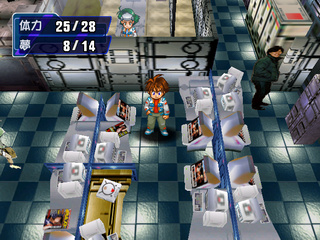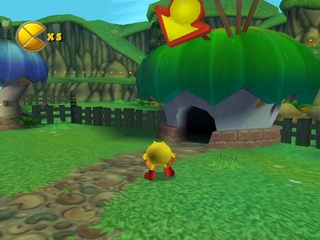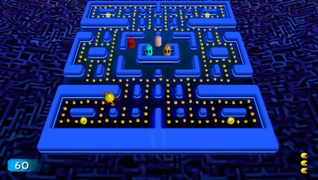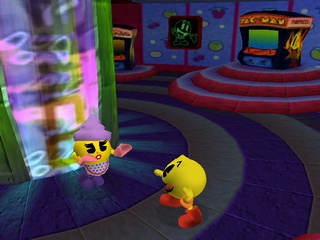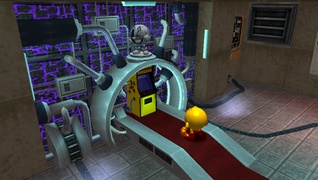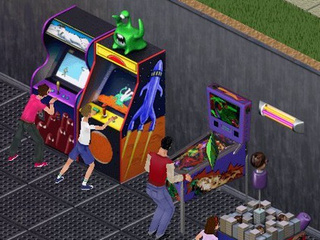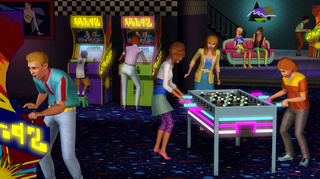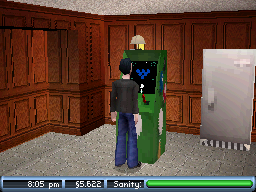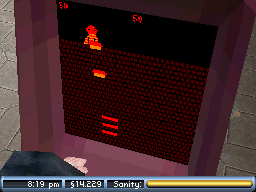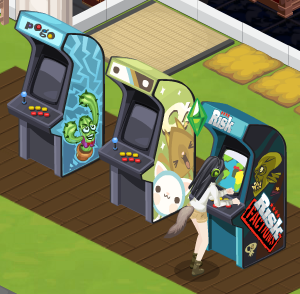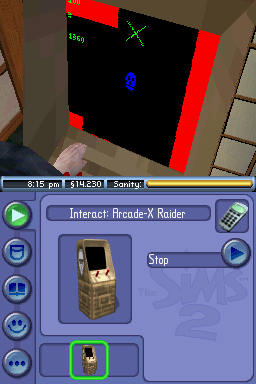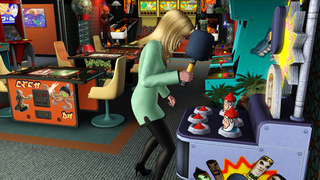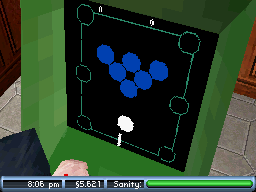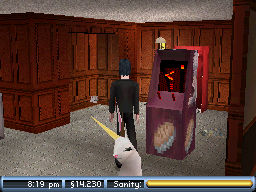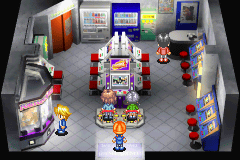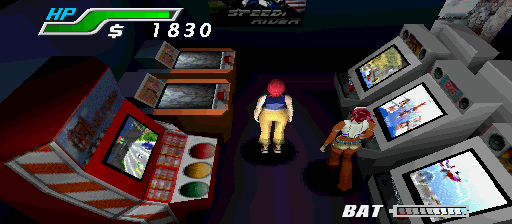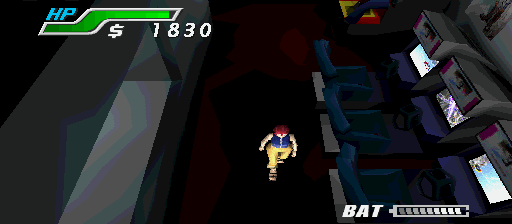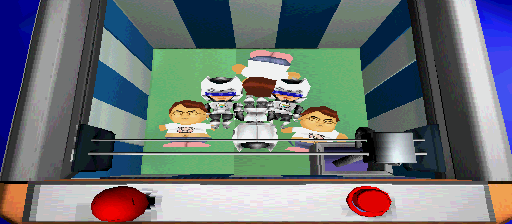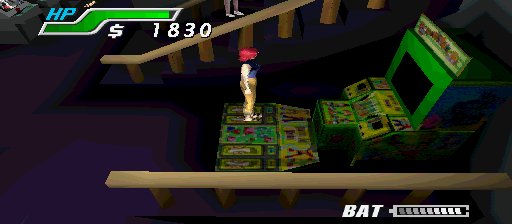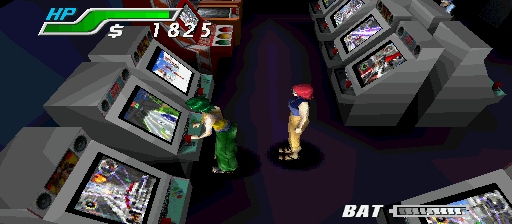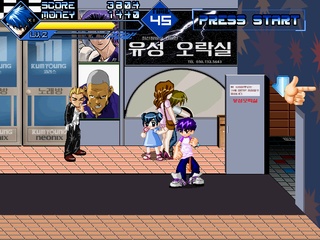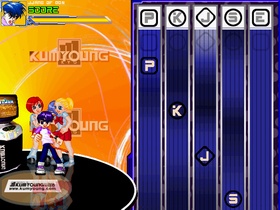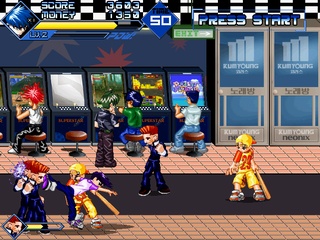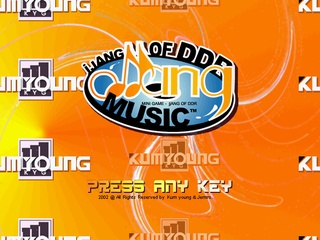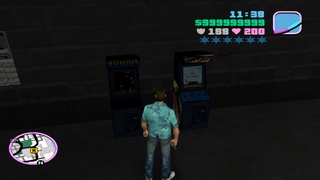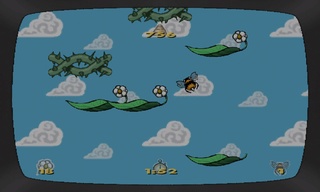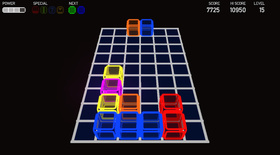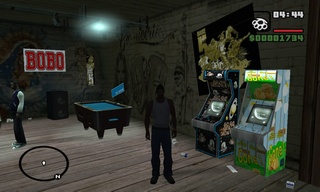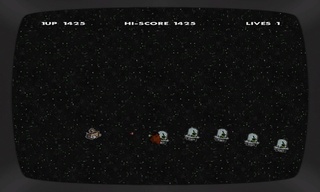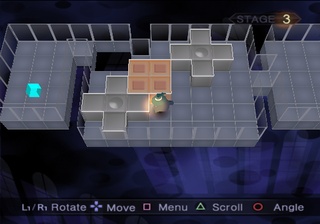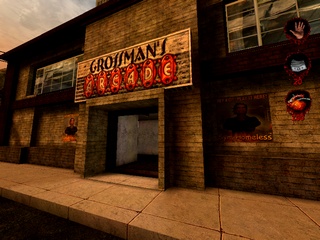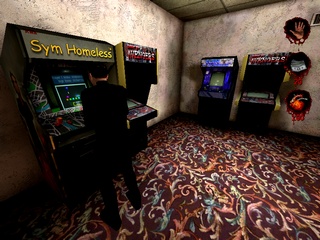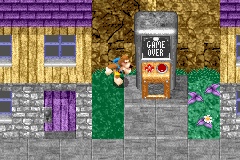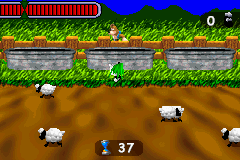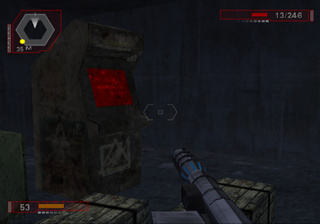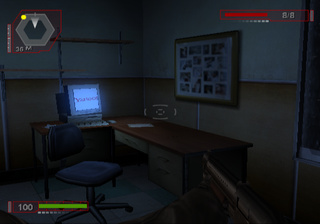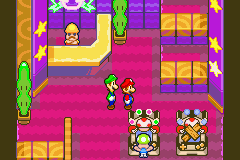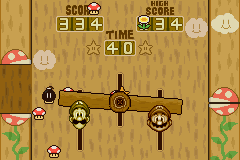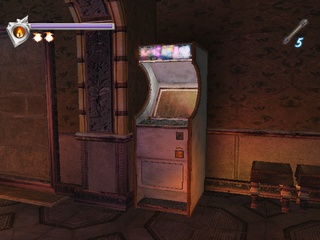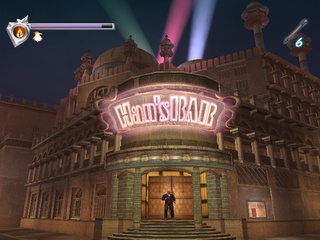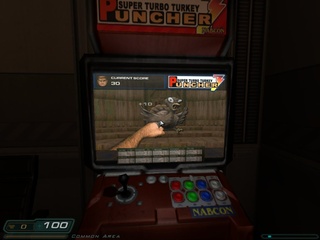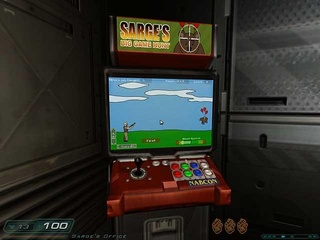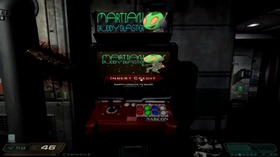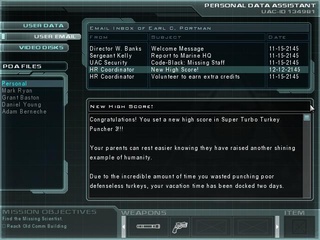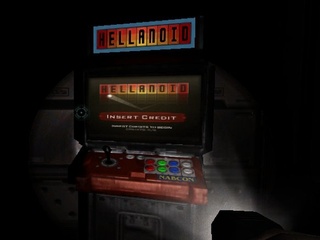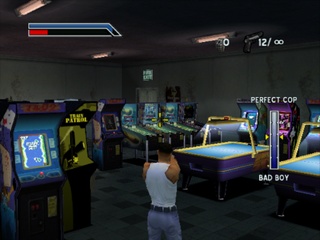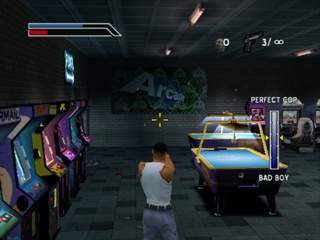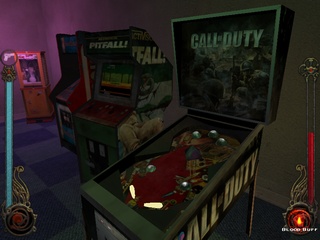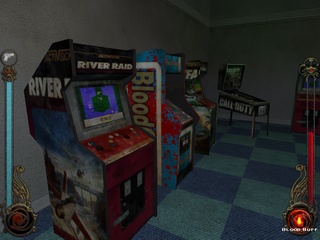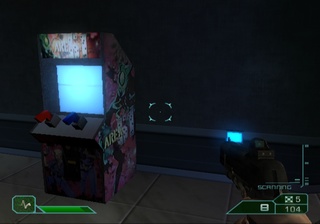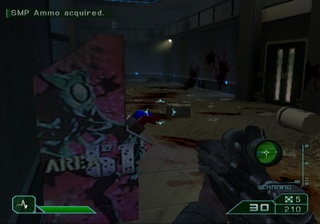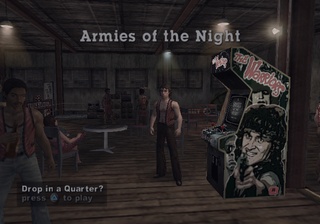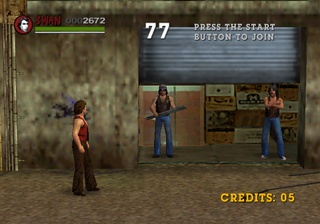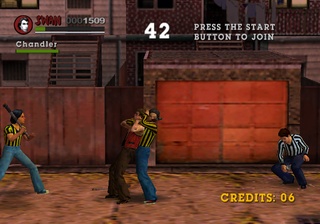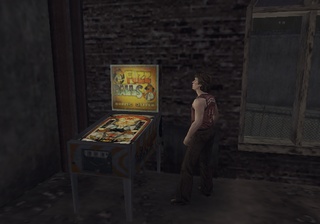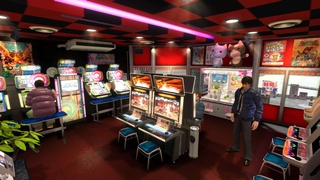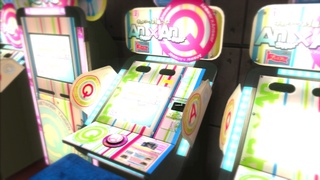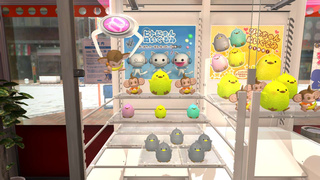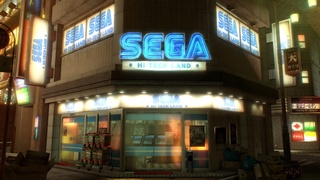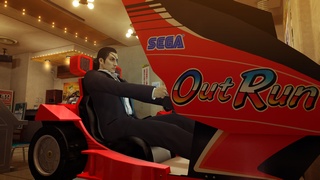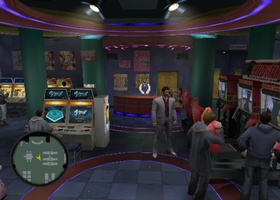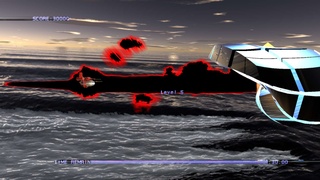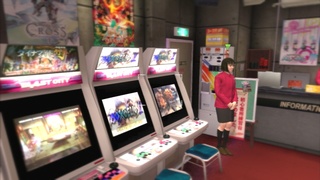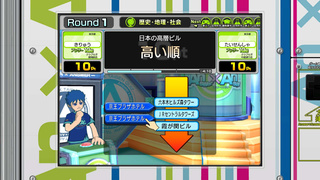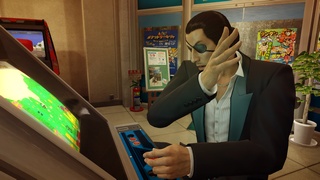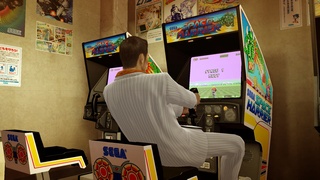
Inventories: Arcades in Video Games
Segagaga (2001)
Segagaga is just a huge Sega self-parody, so you don't only get to meet a whole bunch of Sega characters (poor Alex Kidd working retail...), but also roam the R&D offices with lots of hardware lying around. The focus is on the console business, but there are also arcade machines, and one of the monsters / potential hirelings is a tester sitting in front of what looks like a fighting game. At the climax, the hero mans an old decomissioned cockpit cabinet, which turns into a spaceship in a battle against outdated digitized Sega consoles. Yes, it's pretty crazy.
Zwei!! (2001)
We've mentioned the sequel to Zwei!! for arcade style selection menus, but the first game also has an outdoor arcade area in Undine Land. In the original PC version, only one of the unlabeled cabinets is playable. The game is "Zwei!! Shooting", an R-Type knockoff down to your steampunk plane's propeller behaving exactly like R-Type's force, with the abilities to toss it at enemies and mount it to the rear in order to fire backwards. However, the game is only one stage long. In the later PlayStation 2 version it is also possible to find the PCB for a puzzle game called "Mona Mona", which was a separate desktop app in the PC release.
Pac-Man World series (2002-2005)
The first Pac-Man World already allowed to play the original arcade Pac-Man, as Pac-Man releases tend to do ever since The New Adventures, but it was not presented in an arcade machine form. This changes in the sequel, where the arcade indeed has a very special place. Not only is it introduced at the very beginning, but even presented as one of the major reasons to play the main game at all. By collecting medals, you get access to a variety of variants, from the 1980 original to Pac-Mania, Pac-Attack and Ms. Pac-Man. To play as the missus, however, you need to collect so much stuff, most probably never unlocked the game. Right from the very beginning, you're also allowed to play a Pac-Man World 2 machine. Wait, what? You get to play Pac-Man World 2 within Pac-Man World 2? Well, kind of: The platformer contains a number of mazes, which use the 3D graphics engine but are played in the classic Pac-Man style. These can be replayed here as they are encountered in the main quest.
The next sequel, Pac-Man World 3 does not feature an arcade in the main quest, but through a separate menu you can enter a "Museum" which has various TVs where you can watch an interview with Toru Iwatani and a trailer for Pac-Man World Rally, which also has a sole arcade cabinet of the 1980s original. By finding voxel sprites of the Galaxian aliens (why Galaxian?) Pac-Man can also enter variants of the classic maze game in a tilted 3D view.
The Sims series (2002-2013)
The Sims: Vacation (Windows)
The Sims 3 (Windows)
The Sims 2 (NDS)
The Sims 2 (NDS)
The Sims 2 (NDS)
Arcade machines are available as objects for your houses in most The Sims games. The first one initially only had a pinball table, but two different video games titled "Sim Mars" and "ST2 - Barky's Revenge" were introduced in the 2002 Vacation expansion. The Sims 2: University has "Pimp Viking 3D Arcade Game" and "A-maz-ing Matey!". The console versions add a third machine, whose name is not as well-documented, but it appears to be a shoot-'em-up with an arrow piercing through a heart symbol on the cabinet art. Although the player doesn't see much of the game's content, they all come with silly descriptions in the shop.
The arcade overkill comes with The Sims 3, though, which stacks up no less than seven arcade video games throughout its many expansions (see a full list on The Sims Wiki), alongside pinball tables, basketball hoops, whack-a-mole, foosball and a bunch of other gamey stuff, which inspired players to build magnificent game arcades, and of course mod them to replace the textures with actual classic arcade game art. Even the Facebook spin-off The Sims Social has a few machines.
The Sims Social
The best, however, is the Nintendo DS version of The Sims 2, which offers a selection of playable arcade machines. "Space Armada" is a Space Invaders clone, "Billiards" a rather crude simulation of the sport, in "Pie Factory" you stack pieces of pie, and "X-Raider" is an overhead action shooter like Berzerk.
The Sims 2 (NDS)
(thanks to lanceboyle94 for the NDS screenshots)
Yu-Gi-Oh! The Sacred Cards (2002)
Well, "Gamegame" is an ever so slightly less uninspired name than the game centers in the Mother series, but you can just do as little with it (read: nothing), as all anyone cares about in this world is dueling each other with Yu-Gi-Oh! cards. There are three stories to the building, but arcade games are only on the ground floor - the second floor is a card dueling lounge and the third an office space. At leat you get to listen to a rendition to the Beatmania song "Miracle Moon" while inside.
Manic Game Girl (2002)
Manic Game Girl is the only PlayStation game that was exclusively released in Korea, and it's all about video games. It starts with a menacing meeting in a huge corporation, discussing their nefarious plan to... dominate the market with a new awesome portable video game console! Most of the adventure/brawler hybrid consists of using the virtual reality capabilities (actually more like augmented reality) of the Game Stealth handheld to turn into a Power Ranger and beat up people. Various off-brand consoles can also be found as random pickup items.
But there is also a fairly large arcade area, which contains many generic cabinets that look like they're running shooting and fighting games, a Dance Dance Revolution knock-off, sit-down cabinets for racing games. a machine that measures punching strength and a Bishi Bashi style cabinet with huge colored buttons called "Albatross". The only playable machine, however, is the good old UFO catcher. Incidentally, it is the easiest rendition of the game ever, as you can change the perspective to a straight top-down view, and you even earn a little money when you do a good job.
Manic Game Girl (PlayStation)
Jjang: The Young Boss (2002)
Technically this is another beat-'em-up scroll-by, but the arcade representation is a bit more elaborate in this Korean comic book tie-in. In its short arcade stage, you not only see people play a number of games on generic "Superstar" cabinets, including a fighting game, a tetris variant and a clearly recognizable title screen for Pocket Fighter(!) but also a brazen Dance Dance Revolution ripoff/parody called "Jjang of DDR". After beating the boss in an alley behind the arcade, you get to actually play the rhythm game with a selection of three songs. The timing for the notes is a bit bad, and unless you modified the controls specifically with this mini game in mind beforehand, chances are they're terribly suited for it. They certainly are with the default setting.
Jjang: The Young Boss (Windows)
Grand Theft Auto series (2002-2013)
One of the radio stations in Grand Theft Auto 3 would sometimes talk about a hot new game called "Pogo the Monkey", and even one of the viral marketing mockup homepages for the game was dedicated to it. However, you never could see the game in action. But in Vice City, there are two old cabinets in Kaufman's Cabs, one of them "Pogo the Monkey", even though the game takes place in 1986, long before Grand Theft Auto 3's vaguely present day setting. Right next to it stands a Tetris lookalike named "Degenatron". Both screens show a still image of their respective game, but are not the least bit interactive.
The sequel San Andreas fully embraces game references. Not only does the protagonist Carl own a weird made-up console, but there are also no less than four different playable arcade machines in various places. "Go Go Spacemonkey" is a sidescrolling shooter similar to Gradius, while "They Crawled From Uranus" is a coarsely titled clone of Gyruss and Duality" an Asteroids variant. Only "Let's Get Ready To Bumble" (or "Bee Bee Gone!" in some versions) doesn't seem to have quite as obvious an inspiration. As a bee, you go up a level of vines, leaves and other obstacles in order to collect flowers.
Grand Theft Auto IV scaled back a little on games within the game, but it still contains a playable arcade title with "QUB3D", a fairly original and fun puzzle game, which also appears in Grand Theft Auto 5.
Grand Theft Auto IV (Windows)
Shin Megami Tensei: Nocturne (2003)
Tokyo may have been transformed into a demonic sphere in this episode of Atlus' long-running devil hunter RPG series, but many traces of civilization remain. Strange creatures called Manikin are about to rebuilt Asakusa in traditional Japanese fashion, and a kid even managed to preserve a few games "humans used to play" in the basement. It challenges the half-demon hero to beat "Puzzle Boy", a remake of Atlus' classic puzzle game of the same name, which is best known in the West as Kwirk on the Game Boy. Instead of the usual vegetable-shaped character, the star of this version is the Pyro Jack demon from Shin Megami Tensei. In contrast to the original's 99 rooms, it also only has 20 stages, but the difficulty ramps up much quicker.
Postal 2 (2003)
Grossman's Arcade is a huge two-story building full of arcade machines - too bad that it's only the same four games repeated over and over again, and none of them are playable. The interior is just as rustic as the rest of the town, so there's not much in terms of decoration or auxiliary facilities - no coin exchangers, pinball tables, UFO catchers or the like, just the cabinets and a guy behind a counter. The games have funny names like "Bastard Fish" or "Sym Homeless", but there's only a Space Invaders clone shown on screen for all of them. The local newspaper prints a story about Sym Homeless' questionable community value by training kids to be homeless on monday.
Banjo-Kazooie: Grunty's Revenge (2003)
The small sequel to Rare's buddy mascot collect-a-thon is not too small to include an arcade distraction, but too small to give it any original content. When accessing the machine with N.Kreditzs in store, you get to choose from a total 8 mini games, but they're all recycled from various challenges throughout the adventure. Three are variants of the same fishing game, three send you down a slide, and two are top-down vehicle combat scenes where you fight against 3 AI opponents for possession of a treasure chest or ice crystals.
Terminator 3: Rise of the Machines (2003)
The story of the Terminator 3 game is much larger in scope than the movie it was based on, so CGI Arnie gets to stalk through apocalyptic ruins fighting directly against hordes of endoskeleton Terminators and drones in the future. In one of the destroyed buildings of Hollywood, he finds a truly battered old arcade cabinet. The iconic sideart for Missile Command is just barely recognizable on it, but miraculously it still works. The end of the world is no reason to not take a break for a session of simulated nuclear warfare. Centipede is also playable, but for some reason it doesn't run on an arcade machine but a desktop computer in the veterinary office.
Mario & Luigi: Superstar Saga (2003)
In Little Fungitown, the two Italian brothers find a mushroom house with NES controls mounted to the roof. In the Mushroom Kingdom, this apparently signifies a game center. Inside, two of the four machines are permanently occupied and another broken, once again leaving only one game to play. "The Star 'Stache Smash" is a reaction game where you tilt a platform to let items slide into opening and closing man-eating plants, and beating it for a reward is mandatory to proceed with the story. Even though the arcade machine clearly shows a blue-ish video screen, the design of the mini game seems to imply it's a mechanic game made out of woodwork.
(right side image taken from Super Mario Wiki)
Ninja Gaiden (2004)
It's only a lonely, forgotten cabinet in a corner of Han's Bar, but it can actually play all three games from the classic Ninja Gaiden trilogy in their SNES renditions on it - but only if you find the individual cartridges. Some may think it would have made more sense to make the 1988 arcade game playable, and that's exactly what Team Ninja did for Ninja Gaiden Black. Once the games are unlocked, they can also be accessed directly from the menu, so you don't have to backtrack to this early location in the game to play them.
Doom 3 (2004) and Resurrection of Evil (2005)
One of Doom 3's major tech features was its ability to fluently zoom in on any screen display within the game world without transition, so it would have been a waste to not have some kind of arcade game in there. "Super Turbo Turkey Puncher 3" can be found in the first level of Doom 3. Most of the assets seen on screen are from the old Doom games, only the turkey seems new and the logo riffs on Street Fighter Alpha 3. The manufacturer label reads "Nabcon". It is actually "playable", if you can call it that - you just press the fire button to punch a poor turkey. If you're sadistic enough to keep going until you crack the high score, you receive a message through your built-in email system to congratulate you on your achievement in a rather backhanded way.
"Super Turbo Turkey Puncher 3" was a little lame even compared to other games-in-games of the time, so the Doom 3 expansion pack Resurrection of Evil makes good for it with three much more worthwile arcade machines. "Hellanoid" is, unsurprisingly, an Arcanoid clone, in "Sarge's Big Hunt" you play an unhinged soldier who shoots the balloons of flying bears to make them fall to the ground. "Martian Buddy Blaster" is a kind of crosshair shooter. All three machines are also labeled as having been made by "Nabcon".
Doom 3: Resurrection of Evil (Windows)
(images taken from The Doom Wikia, The Easter Egg Archive, Battleteam.net and Spunky117's Doom 3 ROE Playthrough on Youtube.)
Bad Boys: Miami Takedown (2004)
Bad Boys: Miami Takedown is not a direct adaption of either Bad Boys movie. On the one hand this means that players have to be content with bad Will Smith and Martin Lawrence imitators, on the other hand it allows the game to explore new environments, like a rather spacious arcade in the first stage. It has two full rooms of video games, most of which are depicted as scrolling shooters. "1492" is obviously a parody of Capcom's 1942, "Airmail" looks to be a horizontal scrolling biplane game and "Turmoil" is a generic space shooter. It's hard to interpret what's going on in "Train Patrol", but it looks like the would-be player avatar is a train-mounted cannon in the Old West. There's also a whack-a-mole machine called "Flatten-A-Ferret", a selection of pinball tables and two sit-down cabinets of a racing game called "Sunday Driver". Unfortunately, excitement over this abundance is dampened by the fact that Mike Lowrey cannot interact with anything.
Vampire: The Masquerade - Bloodlines (2004)
In Troika Games' dark, run-down version of Santa Monica a vampire can find a small establishment by the beach, which stocks exclusively activision titles. The games on display are Pitfall and River Raid - neither of which were ever released in arcades. At least they show actual gameplay images on screen, unlike the completely fictional "BloodQuest". For good measure, there is also a pool billiard table, a Call of Duty pinball table and a vintage fortune teller automat called "King Neptun Tells All". But apparently vampires are not into silly pastimes like video games, despite having all the time in the world at their disposal - none of the machine can be interacted with.
Area-51 (2005)
In an early area of Midway's horror FPS Area-51, you can find a cabinet of the arcade game Area-51. It's not necessarily a fourth-wall breaking, as it is the 1995 lightgun shooter which this title is only kind of a remake of. Unfortunately it is not playable, even though it was ported to PlayStation back in the day.
The Warriors (2005)
The Warriors was an unusual property for Rockstar Games to license. After all, the movie was more than 25 years old at the time. It was made before arcade games had really taken off, so the movie hadn't seen any direct video game adaptions before, although games like Double Dragon and Final Fight took very obvious inspiration from it.
The Warriors (PlayStation 2)
In Rockstar's modern interpretation, it's possible to unlock an arcade machine for The Warriors' hideout that plays "Armies of the Night". It tries to be a Double Dragon parody, complete with the intro where goons approach a woman in a dress, punch her in the stomach and take her away, upon which the heroes come out of their garage to pursue the kidnappers. The game plays same as The Warriors minus the team mechanics, though. There's also a pinball table for the hideout. It can be used to access a number of mini games, none of which are pinball.
Yakuza / Ryu ga Gotoku series (2005-2015)
Ryu ga Gotoku 4 (PlayStation 3)
Ryu ga Gotoku 4 (PlayStation 3)
Ryu ga Gotoku 4 (PlayStation 3)
Ryu ga Gotoku 5 (PlayStation 3)
Ryu ga Gotoku 0 (PlayStation 4)
Ryu ga Gotoku 0 (PlayStation 4)
Take sandbox gaming, add Japan and Sega to the mix, and you bet it's going to have some kind of arcade representation. The first Yakuza was still very conservative in its execution, so all you got to play inside was a UFO catcher crane machine. The sequel introduced "YF6", which we can only assume stands for "Yakuza Fighter6". It was presented as created by "MA2", with a familiar looking logo. It's a first person fighting game with Tron-like art design, which is a bit sluggish but reasonably complex and entertaining for a minigame. Kazama can even challenge a number of NPCs to "YF6" matches.
Yakuza 2 (PlayStation 2)
Yakuza 3 replaces the fighting game with a horizontally scrolling shoot-'em-up named "Boxcelius" and a trivia quiz game named "Answer X Answer" which was unfortunately excised from the terribly mutilated English version, alongside many other minigames. Both games were carried over to the next game, and "Boxcelius" even got a sequel. The series went all out with the fifth installment, though - it features a complete, almost arcade-perfect emulation of Virtua Fighter 2 and a rendition of Taiko no Tatsujin, Namco's popular (in Japan) rhythm game series, which is fun but kind of pointless without the corresponding special drum controller.
Yakuza 2 (PlayStation 2)
The recent (and so far Japan only) prequel Ryu Ga Gotoku Zero takes the gangster drama back to the 1980s, so Sega didn't miss the chance to reprise the game center awesomeness of Shenmue with a whole bunch of playable Sega classics in lovely recreated cabinets, including Space Harrier, Super Hang-On, OutRun and Fantasy Zone.
A fact that should be noted about the Yakuza games is that they feature stunningly faithful recreations of real Japanese city areas, and as such the arcades are all from actual Sega game center chains. For most of the games that is the modern Club Sega, but Yakuza 0 takes you back to an old-fashioned Sega Hi-Tech Land, which by now have been mostly phased out from the streets of Japan.
Yakuza 2 (PlayStation 2)
